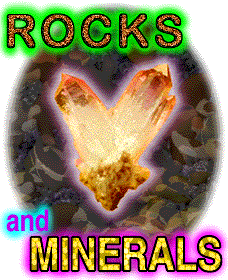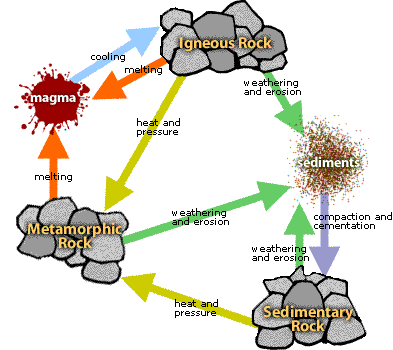


|
A unit on ROCKS AND MINERALS By Bonnie Glasgold, P.S. 101, Brooklyn, New York
|
|
OVERVIEW: This is a series of lessons developed on the exploration and investigation of rocks and minerals. The students will learn what the properties of rocks are, how to distinguish among the different types of rocks, and do various experiments with rocks. They will investigate the hardness of rocks, the effect of acid on certain rocks containing limestone, and perform streak tests to determine a rock's mineral content. They will learn the three types of rocks and how to classify them according to their properties. They will learn what the rock cycle is and compare it to other cycles on Earth. Students will have the opportunity to do many laboratory experiments, including the scratch test for hardness. The students will be using the computer as a tool for creating webs, completing vocabulary databases, importing graphics, and research. They will also use a digital camera and insert those pictures into their documents. Student Level: Grades 3-5 Major Goals and Instructional Objectives: 1. Students will use their senses to become familiar with the characteristics of rocks and minerals. 2. Students will be able to sort minerals on the basis of similarities and differences in identified properties. 3. Students will become familiar with the vocabulary associated with rocks and minerals. 4. Students will become familiar with the three types of rocks (igneous, metamorphic and sedimentary). 5. Students will become familiar with the rock cycle. 6. Students will learn the uses of rocks and minerals. 7. Students will learn their birthstones and related history. 8. Students will conduct hands-on experiments to determine the hardness of rocks, affects of acid, attraction to magnets, and test for mineral color. 9. Students will use technology to enhance their research, create graphs, rock cycles, import pictures, and take pictures with a digital camera and insert them into their document. Timeline: 6-8 classroom periods (approximately 45 minutes each). Setting: Science classroom, homeroom class, computer lab, Museum of Natural History, any park or backyard, a quarry, a riverbed, Delaware Water Gap, and the shore. Assessments: 1. Vocabulary data sheets and tests. 2. Research on rocks and minerals. 3. Experiments on rock hardness. 4. Reports on birthstones. 5. Experiments on mineral color (streak test). 6. Venn Diagrams. 7. Teacher made tests. 8. Create a rock book, with all the work learned included. 9. Standard setting samples of student work, experiments, lab sheets, and reports. 10. Scavenger hunt for rocks. 11. Brainstorming charts and semantic maps and webs. 12. Oral reports. Standards: 1. Students demonstrate understanding of change over time. 2. Students demonstrate understanding of physical positions on Earth. 3. Students will write a report of information. 4. Students will use scientific notation for writing of experiments. 5. Students will demonstrate understanding of graphs. Books/Magazines/Video For Students: Rocks and Minerals: Eyewitness Video, narrated by Martin Sheen, 1996. Aliki, Fossils Tell of Long Ago, New York: HarperCollins Children's Books, 1972. This book is written for elementary school children and explains how fossils are formed and what they tell us about the past. Asimov, Isaac, How Did We Find Out About Coal? New York: Walker and Company, 1980. This book presents a history of fire, considers wood as a fuel, and discusses the formation of coal and the history of its use as a fuel. Bains, Rae Rocks and Minerals Mahwah, New Jersey: Troll Associates, 1985 This book discusses the characteristics and uses of some common rocks and minerals. Cole, Joanna The Magic School Bus: Inside the Earth, New York: Scholastic, 1987. On a filed trip in the magic school bus, Ms. Fizzle's class learns about different kinds of rocks and the formation of the earth. Gans, Roma, Rock Collecting, New York: Harper Collins Children's Books, 1984. This book is for ages four through eight, and guides children on how to start a rock collection and how to identify igneous, metamorphic, and sedimentary rocks. Marcus, Elizabeth, Rocks and Minerals, New Jersey: Troll Associates, 1983. Selsam, Millicent, E. and Joyce Hunt, A First Look at Rocks, New York: Walker and Company, 1984. This book describes the distinguishing properties of various kinds of rocks. Sipiera, Paul P. I Can Be a Geologist. Chicago: Children's Press, 1986. This book describes a variety of jobs and topics of study in the field of geology. Steedman, Scott, Our Planet, New York: Franklin Watts, 1997. A colorful, well-illustrated history of our planet. Explains the formation of the earth, rocks, layering, and minerals. For Teachers: 1. National Science Resources Center: Science and Technology for Children: Rocks and Minerals Teacher's Guide, Smithsonian Institution, Washington, D. C. 1997. This is an excellent resource guide published by the Smithsonian. It gives detailed lesson plans, experiments, and standards for the teacher to use. 2. Blobaum, Cindy, Geology Rocks!, Williamson Publishing: Charlotte, VT, 1999. This is great book that gives 50 hands-on activities to explore the earth. 3. Brennan, Jan and Mary Sanford, Rocks and Minerals, The Education Center, 2000. This is a resource guide that supports NSES Standards for grades 1-3. Excellent projects and hands-on experiments. 4. VanCleave, Janice Earth Science For Every Kid, John Wiley and Sons, Inc.: New York, 1991. This book, like the other books in this series, gives 101 easy experiments that really work! A great asset to the classroom science lesson. Web Sites: http://fi.edu/tfi/units/rocks/rocks.html An excellent site sponsored by The Franklin Institute on line. Written on a child's level, it offers wonderful pictures of rocks and minerals and how to identify them. http://edtech.Kennesaw.edu/web/rocks.html A site that has links to close to a hundred other sites on every conceivable topic on rocks, minerals, and fossils. http://cte.jhu.edu/techacademy/fellows/brannon/webquest/Kmbindex.html#resources A web site that has a web quest task on being a rocks and minerals detective. Suitable for elementary age children. Excellent for use as a follow-up and assessment. http://ivyhall.district96.k12.il.us/4th/kkhp/RocksandMinerals/rocks.html This site has excellent pictures and explanations of the three types of rocks. http://stemnet.nf.ca/CITE/rock.htm An elementary site that explains the rock cycle, three kinds of rocks, and properties of rocks and minerals. http://tqjunior.thinkquest.org/3639/?tqskip1=1&tqtime=0620 A wonderful ThinkQuest site on rocks and minerals. It has information of birthstones as well. http://cobweb.net/~bug2/rock1.htm A site sponsored by the Rock Doctor. Excellent information for young children. He will answer any question and give help as well. http://casdn.neu.edu/~geology/department/staff/colgan/iceland/rocks.htm This site has wonderful pictures and examples of the three different types of rocks and the minerals that make them up. http://rocksforkids.com Excellent site that children can use for research and to start and learn about their own rock collection. Great links to other resources as well. http://surfnetkids.com/rocks.htm A site that gives links to other sites that are kid friendly. Barbara Feldman makes rock hunting easy and fun for kids. Includes games on rocks and minerals, too. http://fi.edu/fellows/payton/rocks/create/index.html This site, the Rock Hound, contains lesson plans and literature connections. It also has wonderful animated graphics for students to use. |
 |
|
 |
 |